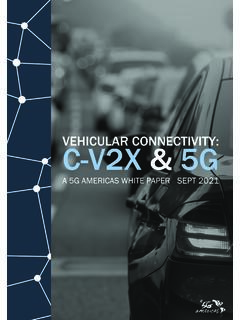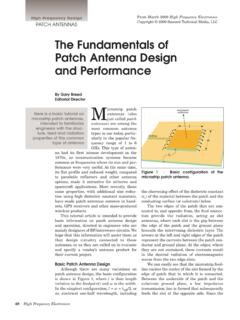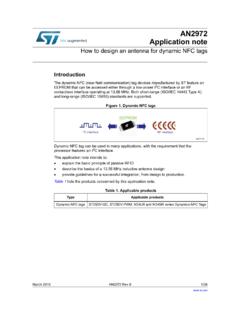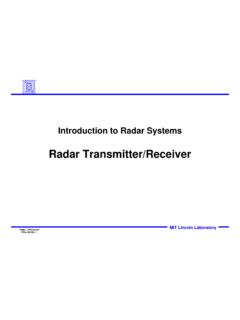Transcription of 5G Americas Advanced Antenna Systems for 5G White Paper
1 - Table of Contents 1. Introduction .. 3. 2. Challenges Addressed by 5G Antenna Methods .. 3. 3. Review of 4G Antennas .. 4. 4. Current Enhancements to the Antenna Side of the Network .. 5. What 5G Promises and How Antennas Will Get Us There .. 5. Spectrum Extension (Sub-6 GHz and mmWave) .. 6. active 6. Network Deployment and Densification .. 7. 5. Multi-Element Array Antenna .. 7. Antenna Technology Fundamentals and Challenges .. 7. Array Theory Grating lobes .. 9. One and Two-Dimensional Beamforming Examples .. 11. 6. Spatial Processing Methods and Functionality - Advanced Antenna System (BF, SU-, MU-MIMO) .. 14. Spatial Processing Techniques .. 14. MU-MIMO versus SU-MIMO .. 15. FD (Full Dimensional) MIMO .. 17. 7. Antenna Array Structure for One and Two-Dimensional Beamforming .. 17. 8. active Antennas versus Passive 19. How mMIMO and mmWave Causes the Shift from RRH to Integrated Antenna .
2 19. 9. Differences Between active and Passive Antennas .. 21. Structure (Hardware) and Function .. 21. active and Passive Antennas Testing .. 25. 10. Trade-Offs for Massive MIMO Antenna .. 27. Massive MIMO in TDD .. 28. Massive MIMO in FDD .. 29. 11. 5G Support for Further Spatial Processing Enhancements .. 29. 5G Americas White Paper : Advanced Antenna Systems for 5G 2019 1. Channel Knowledge .. 29. 12. Spectrum Considerations .. 31. FR1, FR2 and US Spectrum Allocation .. 31. Analog, Digital and Hybrid Beamforming Architectures .. 34. Beamforming Architecture Highlights and Use 36. Path Loss Above 6 GHz (Rain, Foliage) .. 37. Beamforming for mmWave Antennas .. 39. 13. Beam Management .. 39. Initial Beam Acquisition .. 40. Beam Switching/Recovery .. 41. Beam Refinement .. 43. 14. Performance of AAS Features and Deployment 44. Feature 45.
3 Multi-Carrier Deployment Scenario .. 48. 15. AAS in Different Deployment Scenarios .. 49. Deployment Scenario: Dense Urban High-Rise .. 49. Urban High-Rise Macrocell .. 50. Urban High-Rise Street 50. Urban High-Rise In-Building .. 50. Deployment Scenario Urban Low-Rise .. 51. Deployment Scenario Suburban and Rural .. 51. Deployment Scenario Rural and FWA .. 51. AAS Deployment Configuration Choices .. 53. 16. Summary and Conclusions .. 54. Appendix .. 55. A. Definitions and Acronyms .. 55. Acknowledgements .. 58. 5G Americas White Paper : Advanced Antenna Systems for 5G 2019 2. 1. INTRODUCTION. As the demand for throughput, improved user experience and ubiquitous coverage from consumers and corporations continues to grow, operators are quickly improving and expanding coverage and capacity in their wireless network in a cost-effective way.
4 Recent technology developments have made Advanced Antenna Systems (AASs) a viable option for large scale deployments in existing 4G and 5G mobile networks. AASs enable state-of-the-art beamforming and multiple-input, multiple-output (MIMO) techniques that are powerful tools for improving end-user experience, capacity and coverage. These advances have brought mmWave communications, untenable almost two decades 1 ago, to manageable today. AAS. significantly enhances network performance in both uplink and downlink. Finding the most suitable AAS. variants to achieve performance gains and cost efficiency in a specific network deployment requires an understanding of the characteristics of both AAS and of multi- Antenna features. The goal of this Paper is to clarify why AAS is being commercialized now, to describe AAS and how it works, and to explain the relevant complexity/performance drivers.
5 Finally, this Paper examines how AAS is used in real deployments, for both sub-6 GHz and mmWave, and which AAS parameters impact performance in different environments. The Paper is organized into six broad sections, Introduction being the first one. The second section of this Paper is titled as Challenges Addressed by 5G Antenna Methods, which will review how passive antennas, MIMO and beamforming are used today. The technology and challenges in the network are discussed as well as two examples on how grating lobes can impact performance. The next section, Review of 4G Antennas, highlights passive versus active antennas and why a tighter integration of RF electronics and antennas is necessary for massive MIMO (mMIMO) and mmWave antennas. This will highlight how this integration makes Antenna testing more complex. Certain trade-offs of different MIMO antennas that are considered are highlighted.
6 The fourth section, Current Enhancements to the Antenna Side of the Network, includes Chapters 4 through 13. It explains capacity and better utilization of spectrum at both sub-6 GHz and mmWave frequencies. Additionally, Beamforming and Beam management are techniques that allow for higher capacity are explained. The fifth section includes Chapters 14 and 15. It presents use cases, simulations and trial data for AAS in different deployment scenarios for urban, suburban, and rural cases, including both macro and small cell usage. Results reflect the potential of AAS for the wireless industry to improve throughput, capacity and coverage. The last section reviews and summarizes the White Paper . 2. CHALLENGES ADDRESSED BY 5G Antenna METHODS. Network traffic continues to grow rapidly; end-user performance demands continue to increase, straining the Radio Access Network (RAN) to deliver increased coverage, capacity and end-user This requires the wireless operators' networks to deliver gradually higher capacity over time.
7 Since data usage is currently increasing at a much faster rate than corresponding revenue, mobile network operators (MNOs). 1. Hope for LMDS Dwindles, eWeek Networking, August 6, 2001. 2. Ericsson Mobility Report, Ericsson, December 2018. 5G Americas White Paper : Advanced Antenna Systems for 5G 2019 3. must evolve the RAN in a way that enables both a reduced cost per bit and provides the required end-user performance increases. The timing is now right for the telecom industry to make a technology shift to AASs. The shift is driven by the superior performance of AAS in both uplink (UL) and downlink (DL),3,4,5 and the feasibility to build AAS cost effectively. This is supported by technology advances in integration of baseband, radio, and Antenna , and a reduction in the digital processing cost to perform Advanced beamforming and MIMO.
8 The operators adopt new technologies and spectrum as they become available and subsequently accommodate some of the capacity needs. The capacity requirements tend to grow even faster and thus, the operators need additional means to meet the capacity demands. It is usually both difficult and expensive to grow the number of sites. The availability of attractive sites is limited, and the cost and lead time for acquiring a new site is significant. Therefore, operators typically focus on maximizing the use of existing sites before expanding the site grid. AAS is a way to increase Signal to Interference+Noise Ratio (SINR). at the receivers and ultimately increase spectral efficiency. The efficiency of AAS, and particularly the cost efficiency and its advantages to other deployment options, depend on the deployment scenarios. 5G New Radio (NR) enables new bands in the frequency range above 6 GHz, FR2, by adding flexibility and scalability in the numerology.
9 For example, in the mmWave bands allocations at 28 GHz and 39 GHz, very wide operational bandwidths of the order of GHz are made available which support the need for capacity. The radio propagation is much more challenging at mmWave bands in comparison with lower bands in the range of 1-3 GHz carrier frequencies. To secure the reach of the mmWave signals, AASs play an important role to enable coverage via beamforming gain. AASs are enabling enhancements both for capacity and coverage. For lower bands, FR1 (below 6 GHz), the capacity enhancement is more essential due to the more interference limited environment. For the higher spectrum, FR2 (above 6 GHz), coverage enhancement is more essential due to the more challenging propagation and path loss conditions. 3. REVIEW OF 4G ANTENNAS. MIMO and Smart Antenna for Mobile Broadband Systems , 6 published in July 2013 by 4G Americas , provided practical details based upon the latest LTE information through 3 GPP Release 10, on the system performance improvements possible via the efficient use of MIMO for different Antenna schemes for broadband demand.
10 In the 2013 White Paper , fundamental Antenna characteristics with regards to base station Antenna capabilities were considered. Then, the transmission modes 1-9 (SISO through 8x8) as defined by 3 GPP. through Release 10 were reviewed. Considerations for Antenna configurations and capabilities were examined on DL. Some of the salient features were: 1. Open and Closed loop MIMO. 2. SU-MIMO and MU-MIMO. 3. Angle of Arrival beamforming 4. Different Antenna configurations and for different environments Alternate methods for increasing capacity, sector splitting and multibeam antennas, were then discussed. Finally, system performance of these different configurations was considered for Nx2, 2x4 and 4x4 MIMO. 3. 5G NR: The Next Generation Wireless Access Technology, 1st Edition, Dahlman, E; Parkvall, S; Sk ld, J. August 2018, 4. NR - The New 5G Radio-Access Technology, Stefan Parkvall, Erik Dahlman, Anders Furusk r, Mattias Frenne, 2018 IEEE 87th Vehicular Technology Conference: VTC2018-Spring, 3 6 June 2018, Porto, Portugal.








